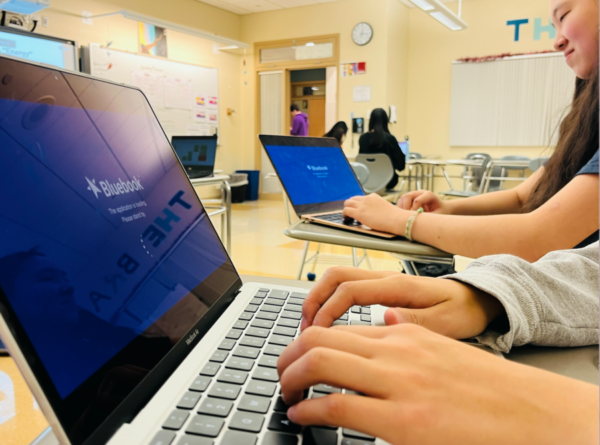For most people, memories of taking the SAT are fraught with visions of testing booklets, a number two pencil, and endless bubbles to be filled in. When College Board, the organization that owns the SAT, PSAT/NMSQT, and AP exams, announced in early 2022 that many of those tests would soon become digital, this shift from paper to digital caused quite the frenzy.
Juniors at the high school got their first taste of the future of standardized testing on October 11 by taking the digital PSAT/ NMSQT during Step-Up Day. Millions of juniors around the country also took the exam that week.
Students expecting to start the exam promptly at 8:00 AM were surprised when Bluebook, the testing platform, encountered undisclosed technical difficulties and delayed the start of the test— by up to an hour in some cases.
The high school’s new Testing Coordinator, Ms. Jen Culver, waited on hold with College Board for close to 40 minutes, attempting to get information about the issue that was leaving hundreds of juniors at the high school unable to begin the exam.
“I was just hearing the hold music the whole time, nothing, nothing,” she said.
Once Culver was able to get College Board on the line, College Board was not able to provide her with a definitive solution.
“They didn’t have an answer for us. Their answer was to just hit refresh,” said Culver.
For the high school’s Technology Department, the issue came as a surprise after weeks of careful planning in preparation for a smooth day of exams.
“We soon learned that [the issue] was, of course, totally not under our control. As everyone heard, it was a College Board issue. Everyone that was testing that day across the nation was having trouble,” said Ms. Ranjani Sriram, the high school’s instructional technology specialist.
Despite the initial issues, one case of individual computer troubles, and one room where there was an unexplainable glitch with the registration of the testing room, students were able to complete the exam as planned or successfully schedule another time to take it.
“We didn’t have anyone who couldn’t take the test. Not one that wanted to take it,” said Sriram.
For the group in the room experiencing the issue with registration, Culver worked with the College Board to reschedule those students’ testing dates to the next week.
Students were able to focus on the exam and learn the new digital format once Bluebook began operating normally.
“Thankfully, I had no tech issues. My only complaint was with the way Bluebook scheduled and timed the breaks,” said Nina Lowe ’25.
As opposed to the traditional format, the digital PSAT and SAT have just two multiple-choice sections for reading and writing and two for math. Students got a break between the reading and writing and the math section, where a timer on their screens counted down the seconds until the next section.
Juniors who took this fall’s digital PSAT will experience the same format for the first digital SAT in March if they choose to take the exam.
On the students’ end, the digital SAT will offer a drastically reduced testing time — two hours and fifteen minutes for the digital format versus the three hours and fifteen minutes for the paper format.
Students can also expect their scores back within “days instead of weeks,” according to College Board.
According to the College Board, 1.9 million students in the class of 2023 took the SAT. A similar number is expected for the March SAT, so the true test of the exam will come this spring.
“We just have to accept that digital is the way things are going,” said Sriram.
For Culver, one bonus of digital administration is that bureaucratic issues that come with traditional paper tests vanished during the digital PSAT.
“Paper tests have so much paperwork, packaging, and you have to do it in a certain way. For the digital PSAT, all you have to do is click away. That’s it. Definitely, from a coordinator point of view, it’s great,” she said

